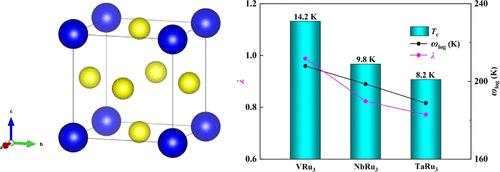Pm-3m MRu3(M = V、Nb 和 Ta)超导性的电子和声波贡献
IF 3.2
3区 化学
Q2 CHEMISTRY, PHYSICAL
引用次数: 0
摘要
据报道,多种过渡金属化合物具有超导特性。受这些发现的启发,我们利用第一原理计算对 Pm-3m MRu3 的状态密度、费米面嵌套函数、振动和超导性进行了研究。计算结果表明,Pm-3m VRu3、NbRu3 和 TaRu3 的超导转变温度(Tc)分别为 14.2、9.8 和 8.2 K。费米嵌套函数和线宽表明,VRu3 的电子-声子矩阵比 NbRu3 和 TaRu3 大。Pm-3m MRu3 的超导性归因于费米能附近的 Ru-d 电子与 M-Ru 振动耦合声子之间的强烈相互作用。导致 MRu3 Tc 不同的因素是费米能附近的 M-d 电子与 M-Ru 耦合振动声子以及 VB 基团原子振动之间的耦合强度不同。本研究的发现提供了重要的启示,可为今后研究和设计基于同族过渡金属化合物的新型超导材料提供参考。本文章由计算机程序翻译,如有差异,请以英文原文为准。

Electronic and Phononic Contributions to Superconductivity of Pm-3m MRu3 (M = V, Nb, and Ta)
Various transition metal compounds were reported to exhibit superconducting properties. Inspired by these findings, we conducted a computational investigation into the density of states, Fermi surface nesting functions, vibrations, and superconductivity of Pm-3m MRu3 by using first-principles calculations. Calculated results reveal that superconducting transition temperatures (Tc) of Pm-3m VRu3, NbRu3, and TaRu3 are 14.2, 9.8, and 8.2 K, respectively. The Fermi nesting function and line widths indicate that VRu3 has a bigger electron–phonon matrix than NbRu3 and TaRu3. The superconductivity of Pm-3m MRu3 is attributed to a strong interaction between Ru-d electrons near the Fermi energy and the phonons of coupled M-Ru vibrations. The factors resulting in the difference in Tc of MRu3 are the varying strengths of the coupling between the M-d electrons around the Fermi energy and the phonons associated with M-Ru-coupled vibrations as well as the atomic vibrations of VB group atoms. The findings of the present study offer significant insights that can inform future research and design of new superconducting materials based on transition metal compounds belonging to the same family.
求助全文
通过发布文献求助,成功后即可免费获取论文全文。
去求助
来源期刊

The Journal of Physical Chemistry C
化学-材料科学:综合
CiteScore
6.50
自引率
8.10%
发文量
2047
审稿时长
1.8 months
期刊介绍:
The Journal of Physical Chemistry A/B/C is devoted to reporting new and original experimental and theoretical basic research of interest to physical chemists, biophysical chemists, and chemical physicists.
 求助内容:
求助内容: 应助结果提醒方式:
应助结果提醒方式:


